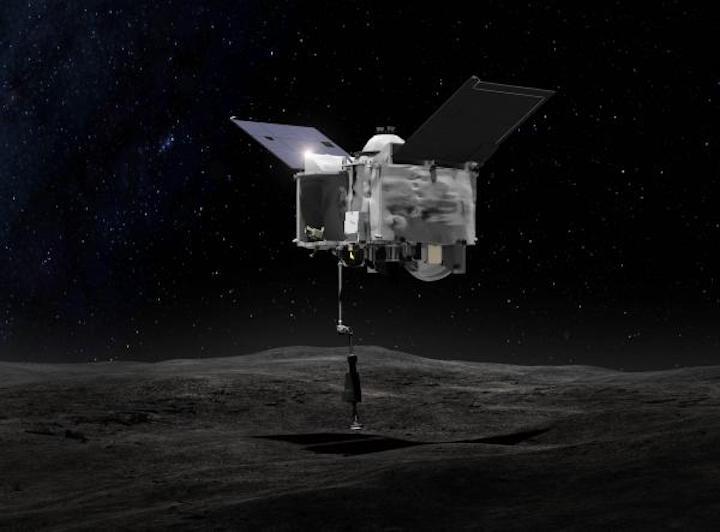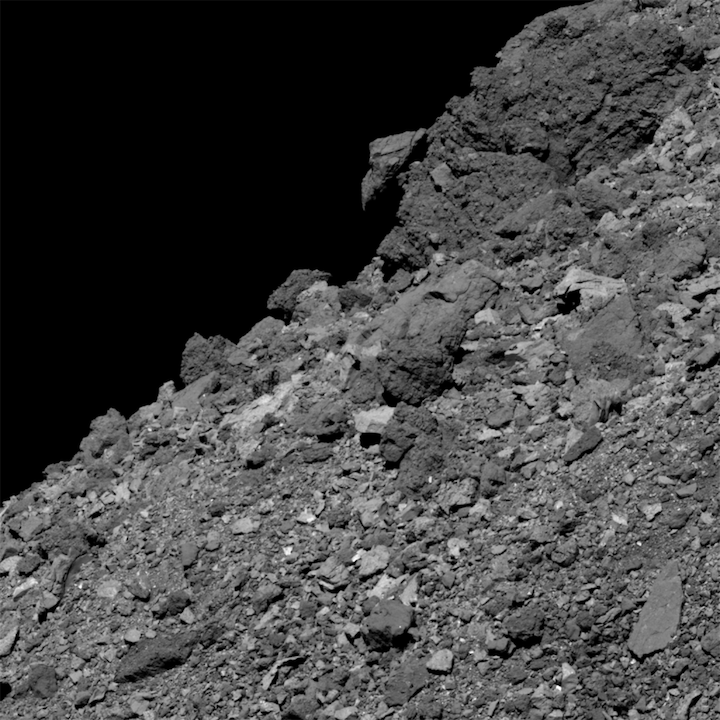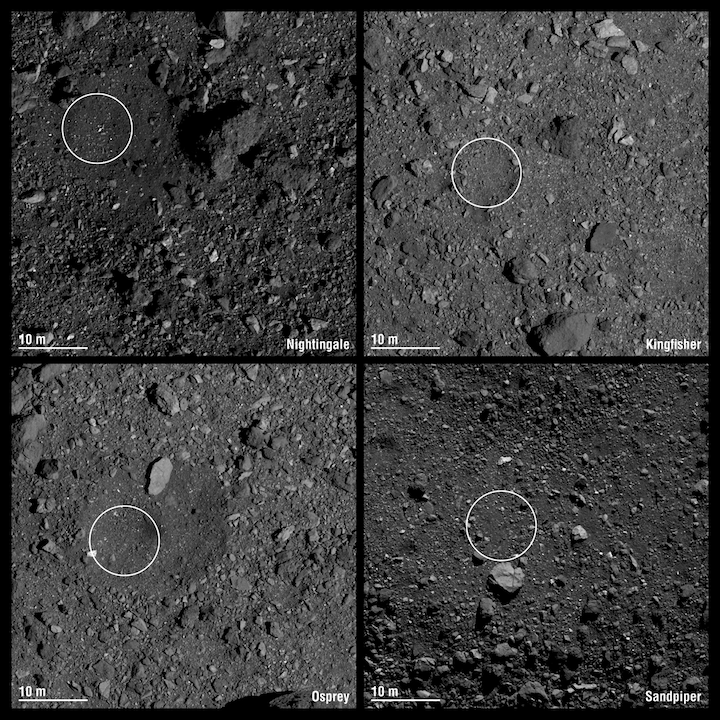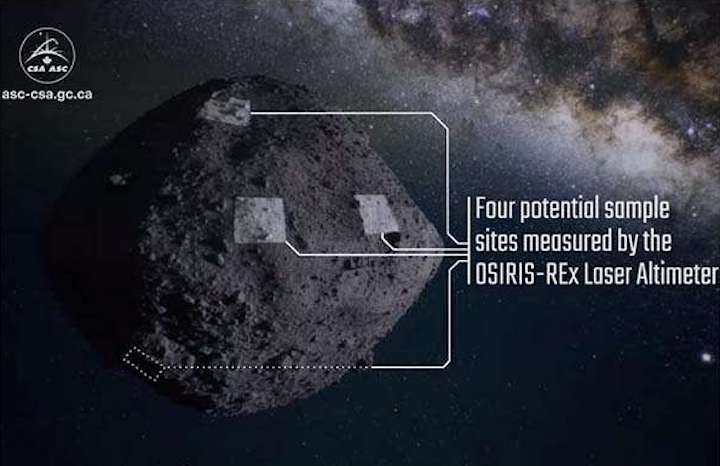27.05.2019
Help NASA Asteroid Mission Choose Sample Site Using PSI’s CosmoQuest

Artist’s concept of OSIRIS-REx collecting its asteroid sample. Credit: NASA
Tucson, Ariz. -- The OSIRIS-REx spacecraft has been at Bennu since Dec. 3, 2018, mapping the asteroid in detail, while the mission team searches for a sample collection site that is safe, conducive to sample collection, and worthy of closer study. One of the biggest challenges of this effort is that Bennu has an extremely rocky surface and each boulder presents a danger to the spacecraft’s safety as it touches down and grabs a sample.
To expedite the sample selection process, the Planetary Science Institute has been funded to develop a hazard map by flagging boulders identified by the public. This will be accomplished by the CosmoQuest program, developed and directed by PSI Senior Scientist Pamela L. Gay, a pioneer of citizen science on the web.
You can help find the best place on asteroid Bennu to collect a sample for return to Earth for study by going to Bennu.cosmoquest.organd marking the locations of small rocks, boulders, and craters in high resolution images. In addition to finding safe places to grab a rock, your data will also help identify other scientifically interesting features on the asteroid.
“CosmoQuest was the first citizen science platform to achieve surface science results from the general public that are comparable to those of professionals,” said Gay. “This is precision work but not difficult work. You need a larger screen so you can use a mouse or track pad to make accurate marks. There is an interactive tutorial to teach you everything you need to know, and the CosmoQuest team is here to help you.”
“For the safety of the spacecraft, the mission team needs a comprehensive catalog of all the boulders near the potential sample collection sites, and I invite members of the public to assist the OSIRIS-REx mission team in accomplishing this essential task,” said Dante Lauretta, OSIRIS-REx principal investigator at the University of Arizona in Tucson.
The mission’s Touch-and-Go (TAG) sampling maneuver is scheduled for July 2020, and the spacecraft will return to Earth with its cargo in September 2023.
SCIENCE CONTACT:
Pamela L. Gay
CosmoQuest director and PSI senior scientist
Quelle: PSI
----
Update: 10.08.2019
.
Asteroid’s Features To Be Named After Mythical Birds
Working with NASA’s OSIRIS-REx team, the International Astronomical Union’s Working Group for Planetary System Nomenclature (WGPSN) approved the theme “birds and bird-like creatures in mythology” for naming surface features on asteroid (101955) Bennu.
OSIRIS-REx is NASA’s first mission to bring a sample from an asteroid back to Earth. The OSIRIS-REx spacecraft has been mapping Bennu’s surface since its arrival on Dec. 3, 2018, looking for a site from which to take a sample. Bennu is the smallest body in the solar system to be orbited and surveyed by a spacecraft at close range.

The named features on Bennu will include several terrain classification types that the IAU also approved for asteroid (162173) Ryugu’s surface features (currently being explored by the Japanese Space Agency’s Hayabusa2 spacecraft). These include craters, dorsa (peaks or ridges), fossae (grooves or trenches) and saxa (rocks and boulders). The last of these types – saxum – is a new feature classification that the IAU introduced earlier this year for small, rocky asteroids like Ryugu and Bennu. These surface features on Bennu will be named after mythological birds and bird-like creatures, complementing the mission’s existing naming theme, which is rooted in Egyptian mythology.
The name OSIRIS-REx is an acronym for the mission’s major concepts and goals, which stands for Origins, Spectral Interpretation, Resource Identification, Security-Regolith Explorer. The name also finds inspiration in the Egyptian myth of the god Osiris. In ancient Egyptian mythology, Osiris is associated with the afterlife, the underworld and rebirth. He granted all life, including sprouting vegetation and the fertile flooding of the Nile River. Similarly, the OSIRIS-REx mission seeks to understand the origin and process of life on Earth by studying Bennu’s carbon-rich regolith.
Bennu was named in 2013 by a 9-year-old boy from North Carolina who won the Name that Asteroid! Competition, a collaboration between the mission, the Planetary Society, and the LINEAR asteroid survey that discovered Bennu. Michael Puzio won the contest by suggesting that the spacecraft’s Touch-and-Go Sample Mechanism (TAGSAM) arm and solar panels resemble the neck and wings in illustrations of Bennu, whom ancient Egyptians usually depicted as a gray heron. Bennu is the ancient Egyptian deity linked with the Sun, creation and rebirth — Puzio also noted that Bennu is the living symbol of Osiris. The myth of Bennu suits the asteroid itself, given that it is a primitive object that dates back to the creation of the Solar System. Themes of origins, rebirth and duality are all part of this asteroid’s story. Birds and bird-like creatures are also symbolic of rebirth, creation and origins in various ancient myths.
The process of naming of Bennu’s surface and features will begin this summer. The OSIRIS-REx team is scheduled to begin detailed reconnaissance on candidate sample sites this fall. Sample collection is scheduled for summer 2020, and the sample will return to Earth in September 2023.
NASA’s Goddard Space Flight Center in Greenbelt, Maryland, provides overall mission management, systems engineering, and the safety and mission assurance for OSIRIS-REx. Dante Lauretta of the University of Arizona, Tucson, is the principal investigator, and the University of Arizona also leads the science team and the mission’s science observation planning and data processing. Lockheed Martin Space in Denver built the spacecraft and is providing flight operations. Goddard and KinetX Aerospace are responsible for navigating the OSIRIS-REx spacecraft. OSIRIS-REx is the third mission in NASA’s New Frontiers Program, which is managed by NASA’s Marshall Space Flight Center in Huntsville, Alabama, for the agency’s Science Mission Directorate in Washington.
Quelle: NASA
----
Update: 13.08.2019
.
NASA Mission Selects Final Four Site Candidates for Asteroid Sample Return

After months grappling with the rugged reality of asteroid Bennu’s surface, the team leading NASA’s first asteroid sample return mission has selected four potential sites for the Origins, Spectral Interpretation, Resource Identification, Security-Regolith Explorer (OSIRIS-REx) spacecraft to “tag” its cosmic dance partner.
Since its arrival in December 2018, the OSIRIS-REx spacecraft has mapped the entire asteroid in order to identify the safest and most accessible spots for the spacecraft to collect a sample. These four sites now will be studied in further detail in order to select the final two sites – a primary and backup – in December.
The team originally had planned to choose the final two sites by this point in the mission. Initial analysis of Earth-based observations suggested the asteroid’s surface likely contains large “ponds” of fine-grain material. The spacecraft’s earliest images, however, revealed Bennu has an especially rocky terrain. Since then, the asteroid’s boulder-filled topography has created a challenge for the team to identify safe areas containing sampleable material, which must be fine enough – less than 1 inch (2.5 cm) diameter – for the spacecraft’s sampling mechanism to ingest it.
“We knew that Bennu would surprise us, so we came prepared for whatever we might find,” said Dante Lauretta, OSIRIS-REx principal investigator at the University of Arizona, Tucson. “As with any mission of exploration, dealing with the unknown requires flexibility, resources and ingenuity. The OSIRIS-REx team has demonstrated these essential traits for overcoming the unexpected throughout the Bennu encounter.”
The original mission schedule intentionally included more than 300 days of extra time during asteroid operations to address such unexpected challenges. In a demonstration of its flexibility and ingenuity in response to Bennu’s surprises, the mission team is adapting its site selection process. Instead of down-selecting to the final two sites this summer, the mission will spend an additional four months studying the four candidate sites in detail, with a particular focus on identifying regions of fine-grain, sampleable material from upcoming, high-resolution observations of each site. The boulder maps that citizen science counters helped create through observations earlier this year were used as one of many pieces of data considered when assessing each site’s safety. The data collected will be key to selecting the final two sites best suited for sample collection.
In order to further adapt to Bennu’s ruggedness, the OSIRIS-REx team has made other adjustments to its sample site identification process. The original mission plan envisioned a sample site with a radius of 82 feet (25 m). Boulder-free sites of that size don’t exist on Bennu, so the team has instead identified sites ranging from 16 to 33 feet (5 to 10 m) in radius. In order for the spacecraft to accurately target a smaller site, the team reassessed the spacecraft’s operational capabilities to maximize its performance. The mission also has tightened its navigation requirements to guide the spacecraft to the asteroid’s surface, and developed a new sampling technique called “Bullseye TAG,” which uses images of the asteroid surface to navigate the spacecraft all the way to the actual surface with high accuracy. The mission’s performance so far has demonstrated the new standards are within its capabilities.
"Although OSIRIS-REx was designed to collect a sample from an asteroid with a beach-like area, the extraordinary in-flight performance to date demonstrates that we will be able to meet the challenge that the rugged surface of Bennu presents," said Rich Burns, OSIRIS-REx project manager at NASA’s Goddard Space Flight Center in Greenbelt, Maryland. "That extraordinary performance encompasses not only the spacecraft and instruments, but also the team who continues to meet every challenge that Bennu throws at us."
The four candidate sample sites on Bennu are designated Nightingale, Kingfisher, Osprey, and Sandpiper – all birds native to Egypt. The naming theme complements the mission’s two other naming conventions – Egyptian deities (the asteroid and spacecraft) and mythological birds (surface features on Bennu).
The four sites are diverse in both geographic location and geological features. While the amount of sampleable material in each site has yet to be determined, all four sites have been evaluated thoroughly to ensure the spacecraft’s safety as it descends to, touches and collects a sample from the asteroid’s surface.
Nightingale is the northern-most site, situated at 56 degrees north latitude on Bennu. There are multiple possible sampling regions in this site, which is set in a small crater encompassed by a larger crater 459 feet (140 m) in diameter. The site contains mostly fine-grain, dark material and has the lowest albedo, or reflection, and surface temperature of the four sites.
Kingfisher is located in a small crater near Bennu’s equator at 11 degrees north latitude. The crater has a diameter of 26 feet (8 m) and is surrounded by boulders, although the site itself is free of large rocks. Among the four sites, Kingfisher has the strongest spectral signature for hydrated minerals.
Osprey is set in a small crater, 66 feet (20 m) in diameter, which is also located in Bennu’s equatorial region at 11 degrees north latitude. There are several possible sampling regions within the site. The diversity of rock types in the surrounding area suggests that the regolith within Osprey may also be diverse. Osprey has the strongest spectral signature of carbon-rich material among the four sites.
Sandpiper is located in Bennu’s southern hemisphere, at 47 degrees south latitude. The site is in a relatively flat area on the wall of a large crater 207 ft (63 m) in diameter. Hydrated minerals are also present, which indicates that Sandpiper may contain unmodified water-rich material.
This fall, OSIRIS-REx will begin detailed analyses of the four candidate sites during the mission’s reconnaissance phase. During the first stage of this phase, the spacecraft will execute high passes over each of the four sites from a distance of 0.8 miles (1.29 km) to confirm they are safe and contain sampleable material. Closeup imaging also will map the features and landmarks required for the spacecraft’s autonomous navigation to the asteroid’s surface. The team will use the data from these passes to select the final primary and backup sample collection sites in December.
The second and third stages of reconnaissance will begin in early 2020 when the spacecraft will perform passes over the final two sites at lower altitudes and take even higher resolution observations of the surface to identify features, such as groupings of rocks that will be used to navigate to the surface for sample collection. OSIRIS-REx sample collection is scheduled for the latter half of 2020, and the spacecraft will return the asteroid samples to Earth on Sept. 24, 2023.
Goddard provides overall mission management, systems engineering, and safety and mission assurance for OSIRIS-REx. Dante Lauretta of the University of Arizona, Tucson, is the principal investigator, and the University of Arizona leads the science team and the mission’s science observation planning and data processing. Lockheed Martin Space in Denver built the spacecraft and is providing flight operations. Goddard and KinetX Aerospace are responsible for navigating the spacecraft. OSIRIS-REx is the third mission in NASA’s New Frontiers Program, which is managed by NASA’s Marshall Space Flight Center in Huntsville, Alabama, for the agency’s Science Mission Directorate in Washington.
Quelle: NASA
----
Update: 2.09.2019
.
OSIRIS-REx's final four sample site candidates in 3D

This animated flyover of each of the four candidate sample collection sites on asteroid Bennu, selected by NASA's OSIRIS-REx asteroid sample return mission, was produced using close-range data from the OSIRIS-REx Laser Altimeter (OLA), an instrument contributed by the Canadian Space Agency
This animated flyover of each of the four candidate sample collection sites on asteroid Bennu, selected by NASA's OSIRIS-REx asteroid sample return mission, was produced using close-range data from the OSIRIS-REx Laser Altimeter (OLA), an instrument contributed by the Canadian Space Agency.
It illustrates the location of each site on Bennu, the topography of each site, and the potential sampling regions that the spacecraft will target, which are 10 meters in diameter.
The laser altimeter on NASA's OSIRIS-REx spacecraft, contributed by the Canadian Space Agency, has produced the highest resolution topographic maps ever of any planetary body. These maps of asteroid Bennu provide three-dimensional, detailed views of the OSIRIS-REx mission's final four candidate sample collection sites, which are designated Nightingale, Kingfisher, Osprey and Sandpiper.
OLA is equipped with two lasers and uses a steerable mirror to rapidly scan the asteroid's surface to produce detailed images of boulders, craters and other geological features. OLA collected scans using its low-energy laser transmitter (LELT) during the spacecraft's low altitude orbit - approximately 700 meters above Bennu's surface.
The LELT is designed to fire 10,000 light pulses per second at the asteroid, and three-dimensional terrain models of the four sites were produced using these light pulses.
High-resolution maps of the four potential sample sites will allow the OSIRIS-REx team to assess the safety and accessibility of each region, locate landmarks that will help the spacecraft navigate during sample collection and identify areas of fine-grained material compatible with OSIRIS-REx's sampling mechanism.
These maps will be crucial for selecting the final two sample collection sites in December.
OLA's LELT will continue to gather Bennu data in tandem with the other instruments on the OSIRIS-REx spacecraft. The final selection of a primary and backup sample collection site will be announced in December 2019, and sample collection is scheduled for the latter half of 2020.
Quelle: SD
----
Update: 3.11.2019
.
This animated flyover of each of the four candidate sample collection sites on asteroid Bennu, selected by NASA’s OSIRIS-REx asteroid sample return mission, was produced using close-range data from the OSIRIS-REx Laser Altimeter (OLA), an instrument contributed by the Canadian Space Agency. It illustrates the location of each site on Bennu, the topography of each site, and the potential sampling regions that the spacecraft will target, which are 10 meters in diameter.
The laser altimeter on NASA’s OSIRIS-REx spacecraft, contributed by the Canadian Space Agency, has produced the highest resolution topographic maps ever of any planetary body. These maps of asteroid Bennu provide three-dimensional, detailed views of the OSIRIS-REx mission’s final four candidate sample collection sites, which are designated Nightingale, Kingfisher, Osprey and Sandpiper.
OLA is equipped with two lasers and uses a steerable mirror to rapidly scan the asteroid’s surface to produce detailed images of boulders, craters and other geological features. OLA collected scans using its low-energy laser transmitter (LELT) during the spacecraft’s low altitude orbit – approximately 700 meters above Bennu’s surface. The LELT is designed to fire 10,000 light pulses per second at the asteroid, and three-dimensional terrain models of the four sites were produced using these light pulses.
High-resolution maps of the four potential sample sites will allow the OSIRIS-REx team to assess the safety and accessibility of each region, locate landmarks that will help the spacecraft navigate during sample collection and identify areas of fine-grained material compatible with OSIRIS-REx’s sampling mechanism. These maps will be crucial for selecting the final two sample collection sites in December.
OLA’s LELT will continue to gather Bennu data in tandem with the other instruments on the OSIRIS-REx spacecraft. The final selection of a primary and backup sample collection site will be announced in December 2019, and sample collection is scheduled for the latter half of 2020.
Quelle: NASA
